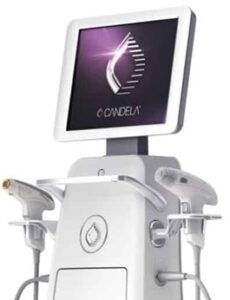Radiofrequency Technologies in Medical Aesthetic
Faramarz Rafie M.D. / Vancoderm Academy (VDA) / Vancoderm Clinic (VDCmed)
Definition:
Radiofrequency (RF) refers to a type of electromagnetic energy within the low-frequency end of the electromagnetic spectrum, typically ranging from 3 kHz to 300 GHz.
Radiofrequency (RF) is a non-invasive aesthetic technology that uses controlled electromagnetic energy to heat the deeper layers of the skin (dermis), stimulating collagen and elastin production. This process leads to collagen remodeling, skin tightening, improved texture, and wrinkle reduction without damaging the skin’s surface.

Types of Radiofrequency in Aesthetic Medicine
Monopolar RF
- How it works: Delivers RF energy from a single electrode, with the current traveling deep through the body to a grounding pad.
- Depth: Deep tissue penetration (up to fat and muscle layers).
- Uses: Skin tightening, body contouring, cellulite reduction.
- Examples: Thermage®, Exilis Ultra™.
Bipolar RF
- How it works: RF energy passes between two electrodes placed close together on the skin surface.
- Depth: More superficial than monopolar; targets dermis and subdermal layers.
- Uses: Fine lines, wrinkles, skin laxity, facial rejuvenation.

Multipolar RF
- How it works: Uses multiple electrodes to deliver RF energy in a more uniform and controlled way.
- Depth: Balanced energy delivery to mid and deep dermis.
- Uses: Full-face tightening, body toning, collagen stimulation.
Fractional RF
- How it works: Delivers RF energy in a grid-like pattern, targeting microscopic zones while sparing surrounding tissue.
- Depth: Controlled micro-injuries reach deep dermal layers.
- Uses: Acne scars, texture issues, wrinkles, skin resurfacing.
Microneedling RF (Fractional RF Microneedling)
- How it works: Combines microneedles with RF energy delivered directly into the dermis.
- Depth: Adjustable penetration into precise skin depths.
- Uses: Acne scars, enlarged pores, wrinkles, skin laxity, stretch marks.
Radiofrequency Technology in Aesthetic Medicine: A Modern Approach to Skin Rejuvenation
In the rapidly evolving world of aesthetic medicine, radiofrequency (RF) technology has emerged as a game-changer for non-invasive skin tightening, rejuvenation, and contouring. With minimal downtime and visible results, RF treatments are becoming a top choice for clients seeking youthful, firm, and radiant skin—without the need for surgery.
What Is Radiofrequency (RF) in Aesthetics?
Radiofrequency is a form of electromagnetic energy that heats the deeper layers of the skin (dermis) without damaging the surface. This controlled heat stimulates the production of collagen and elastin, key proteins responsible for skin firmness and elasticity.
During an RF treatment:
The device emits energy that penetrates the skin’s layers.
Heat is delivered to the dermis, promoting collagen remodeling.
The process leads to skin tightening, reduced wrinkles, improved texture, and a more lifted appearance.
- Key Benefits of RF Treatments
- Non-invasive and painless
- Safe for all skin types
- Minimal to no downtime
- Progressive results that improve over weeks
- Treats fine lines, wrinkles, sagging skin, acne scars, and even enlarged pores
Popular RF-Based Treatments
- RF Microneedling: Combines skin needling with RF for deep rejuvenation.
- Sublative Fractional RF : Fractionated energy to resurface and tighten skin.
- Bipolar or Multipolar RF: Gentle heat for tightening and lifting.
- Body Contouring RF: Firms skin and reduces localized fat.
Ideal Candidates:
RF technology is suitable for:
- Individuals with mild to moderate skin laxity
- Clients looking for preventative aging treatments
- Those not ready or unwilling to undergo invasive surgery
- Anyone seeking refinement of skin texture and tone
Contraindications for Radiofrequency (RF) Treatments:
RF treatments are generally safe, but there are certain medical and safety-related contraindications where treatment should be avoided or postponed:
Absolute Contraindications
- Pregnancy or breastfeeding
- Not recommended due to lack of safety data.
- Implanted electronic devices
- Such as pacemakers, defibrillators, cochlear implants, or neurostimulators, which can be affected by electromagnetic energy.
- Metal implants in the treatment area
- Includes dental plates, screws, or metal-based fillers (can conduct heat and cause burns or complications).
- Active cancer or recent cancer history
- Especially skin cancer or cancer affecting the treatment area.
- Open wounds, active skin infections, or lesions
- Including cold sores (herpes simplex), eczema, psoriasis, or bacterial infections.
- Uncontrolled thyroid disease or hormonal disorders
- Especially for neck treatments (e.g., RF on the thyroid area).
- Autoimmune or connective tissue disorders (Such as lupus or scleroderma, which may affect skin healing or increase sensitivity).
Relative (Precautionary) Contraindications
These may not prohibit treatment but require medical clearance or practitioner discretion:
- Diabetes mellitus (especially uncontrolled)
- Severe rosacea or skin sensitivity
- Use of photosensitizing or skin-thinning medications (e.g., Accutane within past 6–12 months)
- Recent chemical peels or laser treatments in the same area
- Recent cosmetic injectables or surgery in the treatment area
- History of keloid scarring
What to Expect During & After Treatment
- Treatment time: 30–60 minutes depending on area
- Sensation: Warmth with little to no discomfort
- Recovery: Minimal redness or swelling, typically subsiding within hours
- Results: Noticeable in a few weeks, with optimal effects after a series of sessions
Safety Concerns During Radiofrequency (RF) Treatments
While RF treatments are generally safe, proper protocols must be followed to avoid potential risks or complications. Here are the key safety concerns and best practices to ensure optimal outcomes:
- Skin Burns or Overheating
- Cause: Excessive or prolonged energy delivery, especially on thin or sensitive skin.
- Prevention:
- Use proper energy settings for skin type.
- Continuously move the handpiece to avoid heat buildup.
- Monitor skin temperature and patient feedback throughout the procedure.
- Treatment Over Metal Implants
- Cause: RF energy conducts heat through metal, increasing burn risk.
- Prevention:
- Avoid treating areas with underlying metal (e.g., dental plates, screws).
- Conduct a thorough medical history review.
- Electromagnetic Interference
- Cause: RF energy can interfere with pacemakers, defibrillators, or other implanted devices.
- Prevention:
- Always screen patients for electronic implants and contraindicate treatment if present. Eye Safety
- Cause: RF near the eye area can affect sensitive tissues or vision.
- Prevention:
- Use proper eye shields when treating near the orbital area.
- Avoid direct energy near the eyeball unless using specially designed tips.Cross-Contamination & Infection Risk
- Cause: Reuse of non-sterile applicators, especially in RF microneedling.
- Prevention:
- Use sterile, single-use tips when needed.
- Follow strict disinfection protocols between clients.
Pain or Discomfort
- Cause: High energy settings, sensitive skin, or low pain threshold.
- Prevention:
- Adjust energy levels based on client tolerance.
- Offer numbing cream for RF microneedling.
- Provide real-time feedback and allow pauses during treatment.
Post-Treatment Reactions
- Possible Reactions:
- Redness, swelling, temporary skin sensitivity.
- Rare: blistering, hyperpigmentation, or scarring.
- Prevention & Management:
- Follow pre- and post-care instructions.
- Avoid sun exposure post-treatment.
- Use appropriate aftercare products (e.g., calming creams, SPF).
Professional Guidelines
- Operator Training: Ensure only trained and certified professionals perform RF treatments.
- Device Quality: Use FDA- or Health Canada-approved medical-grade RF equipment.
- Client Selection: Always assess for contraindications and suitability before treatment.
The Future of RF in Aesthetic Medicine
As technology continues to evolve, RF-based devices are becoming smarter, safer, and more effective. Combination therapies (e.g., RF + PRP or RF + laser) are redefining skin rejuvenation, offering customized treatment protocols for every skin type and concern.
Conclusion
Radiofrequency is no longer just a trend—it’s a trusted cornerstone of modern aesthetic care. Safe, versatile, and clinically effective, RF treatments provide a powerful solution for clients who want visible, natural-looking results without surgery.
Interested in experiencing RF rejuvenation? Contact our clinic today for a personalized consultation and see how RF technology can transform your skin!
- Written by the clinical team at Vancoderm Academy — leaders in advanced aesthetic medicine and Radiofrequency education. For more information about our treatments or training programs, contact us or visit [vancodermacademy.com, VDCmed.com].

